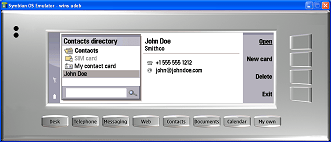
There are lots of bits and pieces out there about the new Communicator, the 9500. It has Wi-Fi and EDGE. We’ll know more later after the official press release. I’ll update the linkage as it comes in. Here’s a link to the webcast at 3pm CET (which is 2pm GMT or 9am EDT or 6am PST).
- Via Russ, Time has an article called Innovate and Dominate. Of interest is the comment on availability: “After all, the gadgets won’t be ready for trial until the summer, or for general commercial use until late in the year.”
- ZDNet: Nokia and IBM unpack new ‘brick’. I love my 9290 brick and would carry one everywhere if it had Wi-Fi and EDGE was more affordable. My favourite quote: “The new phone, which will sell at around 800 euros (£538) and is slightly shorter and lighter than earlier Communicators, flips open to unveil a keyboard and also has the ability to connect to wireless local networks, known as Wi-Fi or Wireless LAN.”
- The Wall Street Journal has a spot on the 9500, but I haven’t read it.
- www.nokia.com/phones/9500 has all of the specs.
- Frank has posted some highlights at Mobitopia.
- Forum Nokia: Nokia 9500.
- Forum Nokia: Series 80 Developer Platform 2.0: API Differences. It looks at the differences between the oldskool 9200 series communicators, the 9500, and Series 90. Designed for hardcore Symbian C++ heads.
Tools and SDKs for developers:
- Series 80 C++ SDK for the 9500.
- Java MIDP SDK for the 9500.
- Java Personal Profile Plug-in for the C++ SDK is an early look at Nokia’s Personal Profile implementation on top of the CDC. It also includes support for the Personal Basis profile and Foundation Profile. It requires IBM WebSphere Studio Device Developer 5.6
I’m still not sure what I think about the 9500. I think it’s great of course, but parts of it feel like a point release or product refresh rather than a big new thing. The connectivity is great and foreshadows what is to come. Choose your connection: GPRS, EDGE, Wi-Fi, or Bluetooth. This is the way it’s going to be.
Overall I like it. It has a camera, the external phone is Series 40, etc. I really wish that Nokia would have decided to put a corporate skin on top of Series 90 rather than continue on with Series 80. Series 80 is great and has served well, but I think that it should be retired. Since the 9500 is a corporate phone, I understand the decision to go with tried and true rather than bleeding edge. At the same time, the 9500 is running on Symbian 7.0s, the same OS that Series 90 runs on.
It looks like corporate software developers will be able to do quite a bit with the platform. I have not looked too deeply at the developer specs, but I see that the phone has MIDP2.0, and hopefully JSR-82 and other APIs neccesary to rock some corporate apps. The 9500 also supports Personal Profile, which has the potential to be much more powerful than poor sandboxed MIDP apps.
At the same time I’m a bit dissapointed. As I said before, I’d much rather see the new communicator running on Series 90, but I’ll have to get over that. It’s very important to remember that the 9500 is designed for the corporate market and not the consumer market. Corporate users want something stable that works, consumers want a cheap phone. It also seems a bit like too little too late. The Communicators have been stagnat for quite some time now. I picked one up used from Craig’s List for $50 a few months ago. I would have liked to see something with even a little less capability quite some time ago. Why did it take so long?
I’ll definitely be keeping an eye on the now revitalized Communicator platform. As long as the MIDP2.0 implementation is pretty good, I can see a lot of people making use of the platform. At the same time, I hope that Nokia has a lot more up their sleeves.














